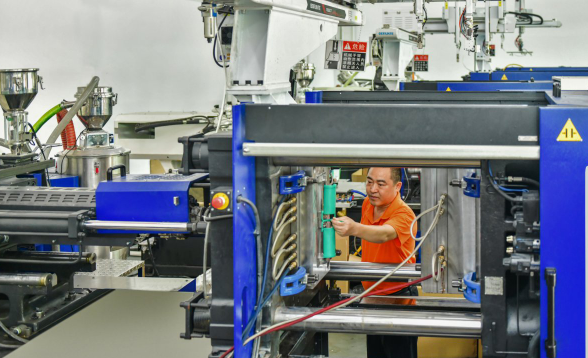
Injection molding is a widely used manufacturing process for producing plastic parts. The process can be broadly divided into two main stages: the Injection Stage and the Cooling Stage. Each stage is critical to ensuring the quality and consistency of the final molded part.
1. Injection Stage
The Injection Stage itself can be further subdivided into two phases: the Injection Phase and the Packing Phase.
Injection Phase
Description:
- In this phase, the plastic material is melted and injected into the mold cavity.
Steps:
- Material Melting:
- Plastic pellets are fed into the hopper and then moved into the barrel, where they are heated by electric heaters. The screw rotates to mix and melt the plastic.
- Injection:
- The molten plastic is injected into the mold cavity through the nozzle by the forward movement of the screw. This is done at high pressure to ensure the cavity is completely filled.
Importance:
- Ensures that the mold cavity is filled with the correct amount of molten plastic.
- Influences the quality and integrity of the final part, including surface finish and dimensional accuracy.
[elementor-template id=”4330″]
Packing Phase
Description:
- After the cavity is filled, additional material is packed into the cavity to compensate for shrinkage that occurs as the plastic cools.
Steps:
- Pressure Maintenance:
- The screw continues to apply pressure to ensure that any shrinkage in the material as it cools and solidifies is compensated for by the addition of more molten plastic.
- Material Addition:
- Additional material is packed into the cavity to ensure the part is fully dense and free of voids.
Importance:
- Reduces the likelihood of defects such as sink marks and voids by ensuring that the mold cavity remains completely filled as the plastic solidifies.
- Helps maintain the part’s dimensional stability and surface quality.
2. Cooling Stage
Description:
- In this stage, the molten plastic inside the mold cools and solidifies into the shape of the mold cavity.
Steps:
- Heat Dissipation:
- The mold is equipped with cooling channels through which coolant (usually water) circulates to absorb and dissipate the heat from the molten plastic.
- Solidification:
- The plastic solidifies as it loses heat, forming the final shape of the part.
Importance:
- Proper cooling is essential to ensure dimensional stability and part quality.
- Insufficient or uneven cooling can lead to warping, sink marks, internal stresses, and other defects.
[elementor-template id=”4331″]
Additional Considerations
While the two primary stages of injection molding are the Injection Stage and Cooling Stage, other important steps occur before and after these stages to complete the injection molding process:
- Clamping:
- Before injection, the mold halves are clamped together with sufficient force to keep them shut during the injection process.
- Mold Opening:
- After cooling, the mold is opened, and the part is ejected.
- Ejection:
- The solidified part is ejected from the mold cavity, ready for any post-processing if needed.
Conclusion
The two main stages of injection molding—the Injection Stage (comprising Injection and Packing Phases) and the Cooling Stage—are critical to producing high-quality plastic parts. Each stage must be carefully controlled and optimized to ensure the desired properties and dimensions of the final product. Proper understanding and management of these stages help in achieving consistent quality and efficiency in the injection molding process.
Related Conten: Custom Plastic Extrusions
 DTG Mould Trade Process |
|
| Quote: | According to sample, drawing and specific requirement. |
|---|---|
| Discussion | Mold material, cavity number, price, runner, payment, etc. |
| S/C Signature | Approval for all the items. |
| Advance | Pay 50% by T/T |
| Product Design Checking | We check the product design. If some position is not perfect, or can not be done on the mould, we will send customer the report. |
| Mold Processing | Send report to customer once each week |
| Mold Testing | Send trial samples and try-out report to customer for confirmation |
| Mold Modification | According to customer’s feedback. |
| Balance Settlement | 50% by T/T after the customer approved the trial sample and mould quality. |
| Delivery | Delivery by sea or air. The forwarder can be designated by your side. |
 |
|

